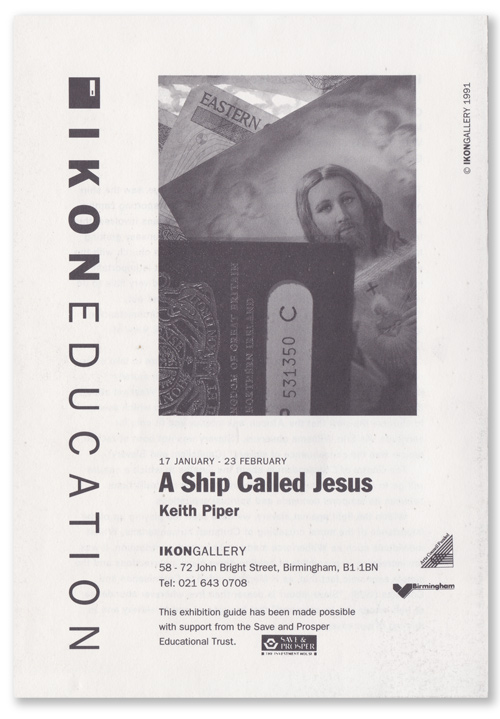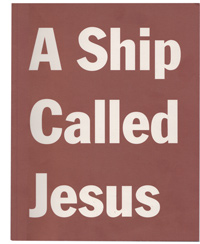This event marked the opening of a relationship between peoples of African descent and the symbols, rhetoric and morality of the English Christian church. In 1564, we were forced to embark on a voyage in a Ship named Jesus. Metaphorically, we have been sailing in her ever since. This exhibition of three installations exists as an examination of some of the traumas and transitions which we have encountered during that voyage.
The Ghosts of Christendom
Onward Christian Soldiers,
Marching as to war
With the Cross of Jesus
Going on before
The first leg of that voyage, the notorious middle passage, saw the ship named Jesus in the role of vessel of containment, transporting captive Africans from the Old World to the New. For the Africans involved, this transition was catastrophic. For Europeans, it saw the uneasy grafting together of the moralistic paraphernalia of the Christian church with the essentially amoral demands of commerce and capital.
It is important however to acknowledge that slavery in and of itself had very little to do with questions of morality. As Gibbon Wakefield pointed out, "The reasons for slavery are not moral, but economic circumstances; they relate not to vice and virtue, but to production." (A View of Colonisation, 1849).
This, however, is too mercenary a view for any culture to take of its own activities. The necessity to feel that one occupies a morally justifiable position is fundamental. In line with this the West
set about constructing a body of scientific and biblical arguments which seemed to endorse the view that the African was inferior and fit only for servitude. As Eric Williams observes, "Slavery was not born of racism, racism was the consequence of slavery" (Capitalism and Slavery).
The Ghosts of Christendom is about the lengths to which a culture will go to alleviate its guilt and to smooth over the contradictions between its temporal demands and spiritual aspirations.
Within the fight against slavery, we have seen the playing up of the importance of the moral crusading of Christian humanitarians. Whilst individuals such as Wilberforce made an important contribution, it was the increasing impossibility of holding down slave insurrections and the simple economic fact that, as H Merivale noted in Colonisation and Colonies (1928), "Slave labour is dearer than free wherever abundance of free labour can be procured" that brought an end to slavery and to this leg of our voyage.
|
The Rites of Passage
Steal away,
Steal away
Steal away to Jesus
Steal away
Steal away home
I ain't got long to-stay here
The second leg of this voyage explores the various traumas of transition which have taken place in the area of race relations within recent history of the Christian church. In a sense, to extend the metaphor, the ship named Jesus has during this stage of the voyage played host to a mutiny: a sometimes fierce, sometimes protracted, sometimes traumatic struggle for control of the helm. lt is a voyage during which, to varying degrees, power over the aesthetics and symbolism of the church has been wrested away from the historically enfranchised white Christian establishment and has reformed around the particular cultural, social and economic aspirations pf a historically disenfranchised black congregation. What we have witnessed however, is not just a transition in the formal aspects that make up Christian aesthetics, but also a resurfacing of profoundly Afrocentric modes of worship.
Central to this part of the exhibition is the theme of passage through water. It is a theme echoed not only in the Christian ritual of baptism, but also in the migration of peoples of African descent to England in the 1950s and 60s.
The ritual of baptism - passage through water, hoped-for spiritual transformation of the individual - also acts to echo the transformation of the cultural and aesthetic orientation of Black Christianity. The act of migration? passage over water, hoped-for economic transformation of the individual - all too often led to the trauma of displacement and loss which in turn would find its own reflection in the imagery of the Black church..
The Rights of Passage is about transformation, but such rites are also essentially insular. They are about the consolidation of personal and collective spaces against the backdrop of a hostile political climate. |
| |
The Fire Next Time
God gave Noah
the rainbow sign
no more water
the fire next time
The final leg of this voyage is about the Black church stepping out into the maelstrom of politics. It is, in a sense, the closing of the triangle, bringing with it its own set of traumas and dilemmas.
A principal attraction of religion lies in its attempt to find or to impose order upon a disorderly world. At its finest moments, such as during the Civil Rights movement, or the struggles against Apartheid, this has inspired the Black church to act as a focal point for collective demands for social and political justice.
During other moments, however, the desire to see order imposed against a backdrop of frantic technological change, shifting morality and social fragmentation, has seen the church attempting to stop history in its tracks. Christians sing "We have an anchor" expressing the desire for a sense of stability, but this desire often spills over into demands that society as a whole anchors itself to the fixed fundamentals of the so-called Biblical truth.
The fundamentalist would not only argue for a religious fixedness in a chaotic world, but would also see the necessity of purging society of those elements which generate that 'chaos'. Central to this process is the purifying flame, the classic icon of retribution.
The Fire Next Time is about the language and iconography of religious fundamentalism with its particular and problematic appeal against the backdrop of the modern world. It is also about the way in which this language is rooted in anxiety and has implications which stretch far into the realm of politics, economics, culture and social control.
Keith Piper 1991
|

